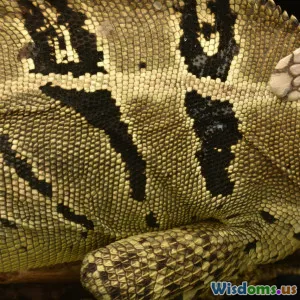
Comparing Famous Cryptids Real Sightings versus Hoaxes
9 min read Explore famous cryptid encounters—separating authentic sightings from deliberate hoaxes with real examples. (0 Reviews)
Comparing Famous Cryptids: Real Sightings versus Hoaxes
Cryptids—mysterious creatures lurking just outside the boundaries of accepted science—have captivated human imagination for centuries. From the murky depths of Loch Ness to the untamed forests of North America, tales of unknown beasts provoke a blend of curiosity, skepticism, and wonder. Yet among these wonderous stories lay a tangled web of truth and deception. This article unravels the complex relationship between legitimate cryptid sightings and hoaxes, illustrating how each shapes public perception and the ongoing mystique of these elusive creatures.
Introduction: The Allure and Ambiguity of Cryptids
The lore of cryptids such as Bigfoot, the Chupacabra, and the Loch Ness Monster has become embedded in global culture. To believers, these creatures are fascinating proof of Earth's hidden biodiversity or remnants of prehistoric times. To skeptics, they are often mistaken animals, folklore spun out of proportion, or fabrications created for fame and fortune.
But the line between reality and myth isn't always clear. Distinguishing genuine encounters from elaborate hoaxes is a nuanced pursuit that challenges researchers, skeptics, and enthusiasts alike. Exploring real sightings alongside infamous fabrications offers profound insights into human psychology, cultural storytelling, and the scientific process.
Real Sightings: Credible Encounters that Spark Intrigue
Bigfoot: Detailed Witness Accounts and Physical Traces
Among North American legends, Bigfoot is one of the most reported cryptids, with thousands of sightings annually. While no definitive physical specimen exists, some encounters exhibit compelling consistency. For instance, the 1967 Patterson-Gimlin film captures a figure purportedly walking through Northern California woods. Though debated, many experts assert the film's authenticity given the lack of indications of fakery under extensive analysis.
Moreover, numerous tracks and audio recordings—like the renowned “Sierra Sounds” recorded in the 1970s—contain phenomena difficult to explain. These acoustic recordings capture vocalizations not matching known animals, which some cryptozoologists argue suggest an unknown primate species.
The Mothman: Predicted Tragedies and Credible Witnesses
In the 1960s, multiple eyewitnesses in Point Pleasant, West Virginia, reported sightings of a towering, winged creature with glowing red eyes, dubbed the Mothman. Credibility came from the consistency of descriptions by independent witnesses, including respected newspapers and local authorities.
Significantly, many accounts were linked temporally to the tragic collapse of the Silver Bridge in 1967. Researchers debate whether the Mothman was an omen, a misidentified bird species like the barred owl, or a supernatural entity, but the documented human testimonies remain compelling.
The Okapi and Chupacabra: Lessons from Cryptids That Became Confirmed Species or Known Animals
Historically, some cryptids were accepted due to unfamiliarity with exotic species or animals exhibiting mysterious behavior. The Okapi, once considered mythical, was scientifically described after indigenous reports led to exploration. On the other hand, the notorious Chupacabra, claimed to drain livestock blood, has often been identified as coyotes suffering from mange, a viral skin disease distorting their appearance.
This demonstrates how real sightings sometimes mix with misinterpretations, requiring thorough scientific analysis to separate fact from folklore.
Hoaxes: Deliberate Deceptions that Complicate the Cryptid Landscape
The Patterson-Gimlin Film Controversy
Despite continued debates about the Bigfoot film's authenticity, skeptics have pointed to testimonies from contractors and friends claiming it was an elaborate costume stunt by Roger Patterson and Bob Gimlin. Critics highlight anatomical inconsistencies and question why more recent clear evidence has not surfaced, suggesting a lasting but possibly fabricated cultural phenomenon.
The Cardiff Giant: A 19th-Century Paleo-Hoax
The Cardiff Giant, discovered in 1869, was a carved gypsum statue presented as a petrified prehistoric man, attracting widespread attention from believers eager to decrypt ancient mysteries. Later admitted as a hoax by its creators for profit and notoriety, it serves as an early example of how cryptid lore can be engineered and exploited.
The Fiji Mermaid: Fabricated Curiosities for Spectacles
As part of showman P.T. Barnum's sideshows, the Fiji Mermaid combined monkey and fish parts to create a grotesque yet captivating exhibit, fooling some and entertaining many. It was not a claim of discovery but rather a known carnival scam highlighting humanity’s appetite for oddities.
The Chupacabra Films and Photos: Modern Media Manipulation
Since the mid-1990s, images and videos purportedly capturing the Chupacabra have proliferated online. Many have since been debunked as hoaxes or mistaken animals such as mangy dogs. These modern fabrications demonstrate how the internet can amplify misinformation and complicate authentic investigation.
Analyzing Why Hoaxes Persist and Influence Perception
Hoaxes endure because they satisfy human curiosity and taps into desire for mystery. They often exploit ambiguities in eyewitness accounts or scientific unknowns. In many cultures, these stories take on symbolic or entertainment value more than literal truth.
Psychologists suggest hoaxes thrive on cognitive biases such as pattern recognition and confirmation bias—our brains seek meaning even where none exists, and evidence aligning with personal beliefs is favored.
Media amplification and commercialization incentivize producing sensational claims. This economic angle can sometimes overshadow efforts toward scientific scrutiny, making it challenging for audiences to differentiate honest observation from manipulation.
Conclusion: Embracing the Mystery While Demanding Rigor
Famous cryptids continue to fascinate because they occupy the liminal space between known reality and unknown possibility. Comparing verified sightings to hoaxes encourages a more informed appreciation of this phenomenon. Authentic reports pushed scientific inquiry toward new species and deeper natural understanding, while hoaxes remind us of the importance of skepticism, verification, and ethical storytelling.
To engage responsibly with cryptid lore means balancing open-mindedness with critical analysis. Whether inspired by a glimpse of a legendary beast or intrigued by an elaborate ruse, the human fascination with cryptids enriches cultural mythologies and challenges us to explore the boundaries between fact and fiction.
As technology and research methods advance, long-standing mysteries might eventually yield toward scientific clarity—but the allure of the unexplained will persist, feeding curiosity and imagination for generations.
References:
- Meldrum, Jeffrey. Sasquatch: Legend Meets Science (2006)
- Radford, Benjamin. Scientific Paranormal Investigation (2016)
- Bartholomew, Rachael. "The Psychology of Hoaxes," Psychology Today (2019)
- Nickell, Joe. Tracking the Man-Beasts (2002)
- Local news archives on the Mothman sightings (1966–67)
Disclaimer: This article aims to educate about cryptid lore and related phenomena, providing examples for critical examination rather than endorsement of supernatural claims.
Rate the Post
User Reviews
Popular Posts



















